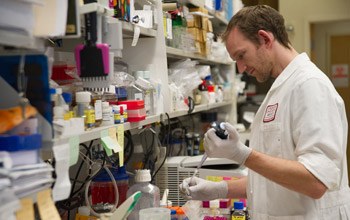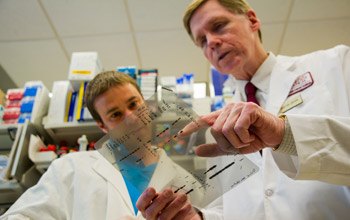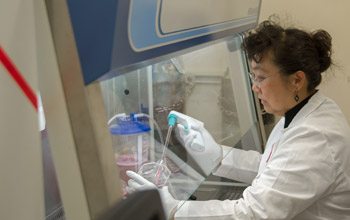The Long Road to Understanding Kidney Cancer
W. Marston Linehan investigates kidney cancer gene pathways to find new treatment strategies.

Dr. Linehan in the lab.
When W. Marston Linehan, M.D., came to the NIH more than 30 years ago, doctors thought of kidney cancer as a single disease. There was no effective therapy for its advanced stages, and 80 percent of patients with advanced kidney disease died within two years. Since then, Linehan has found new understandings of the numerous cancers occurring in the kidney. In addition, he has led novel approaches to treating both sporadic (non-inherited) and familial (inherited) forms of the diseases.

Postdoctoral fellow Christopher Ricketts, Ph.D., prepares samples for analysis.
In the early 1980s, Linehan and Berton Zbar, M.D., began studying tumors from patients with sporadic kidney cancer, aiming to identify a kidney cancer gene that could lay a foundation for developing a targeted therapy. With tissue from those tumors, the team found an abnormality on chromosome 3 that they suspected might indicate the presence of a kidney cancer gene.

Jean, a patient with von Hippel-Lindau syndrome, discusses the progress of her treatment with research nurse Geri Hawks and Dr. Linehan.
“Unfortunately, we came to the sad realization that, with my laboratory working 13 hours a day and six days a week and his lab working 13 hours a day and six days a week, and with the tools available to us at the time, we could find the kidney cancer gene in this location on chromosome 3 within … about … 54-and-a-half years,” Linehan says.

Postdoctoral fellow Dan Crooks, Ph.D., and Dr. Linehan examine results of a metabolic screening.
So, taking advantage of the freedom and flexibility of conducting research in the IRP, they recalibrated to focus on familial kidney cancers, seeking faster answers. Swiftly, Linehan and Zbar established a hereditary cancer program at the National Cancer Institute and brought in support from more than 140 staff across 29 different NIH branches.
The first familial cancer the new program investigated was von Hippel-Lindau (VHL), a genetic syndrome causing some patients to develop tumors in the kidneys and other organs. Linehan and his colleagues brought families affected by VHL from around the country to the NIH Clinical Center in Bethesda, Md.

NIH staff member Regina (left) and Eric, a participant in research on HLRCC, meet in the clinic.
Over the next 10 years, the team analyzed DNA from more than 4,000 individuals and, in the spring of 1993, found the VHL gene – the sixth human cancer gene ever identified. Linehan and others continued the research that provided new insights into the VHL gene’s function and the foundation for the development of seven novel drugs targeting the VHL gene pathway that were approved by the FDA.

Lab Manager Youfeng Yang, M.S., prepares cultured cells for examination.
In the course of identifying the VHL gene, Linehan’s team also discovered and described a new disease: hereditary papillary renal carcinoma, or HPRC.
“HPRC is a very rare disease,” Linehan explains. “To date, only about 25 families in the world are affected by it, so we recruited those families here to the Clinical Center, from the U.S., Canada and other parts of the world. Again we conducted genetic linkage analysis, and seven years later we identified the HPRC gene, MET, in 1997.”
Linehan’s successes enabled program expansion to include additional hereditary and non-hereditary kidney cancers, some of them incredibly complex, rare, and deadly diseases. One example is Birt-Hogg-Dubé (BHD) syndrome, in which kidney cancers arise from mutations in the folliculin gene. Another is hereditary leiomyomatosis and renal cell cancer (HLRCC), a rare disease in which patients can develop a very aggressive form of type 2 papillary kidney cancer.

Drs. Crooks (right) and Linehan monitor output from the extracellular flux analyzer, a machine that measures metabolic changes such as oxygen consumption and glycolysis in cells.
Every patient he sees personally affects Linehan, but one particular family comes to mind when he considers the source of his never-ending drive to better understand kidney cancers. In this family, an 18-year-old woman he operated on to remove a large kidney tumor died of advanced kidney cancer nine months later, and her mother, who also had kidney cancer, died 14 months after her daughter.

Dr. Linehan meets with Roger, a patient with BHD, to discuss the treatment plan.
“It took us 18 years to figure out that what that family had is characterized by a mutation in the fumarate hydratase (FH) gene, which codes for an enzyme vital to ensuring that living cells generate energy during oxidative phosphorylation,” he says.
In studying the FH gene pathway, Linehan and others have demonstrated that kidney cancer is fundamentally a metabolic disease. That finding, like so many from Linehan’s research, promises a smoother road for future kidney cancer research.
W. Marston Linehan, M.D., is the Chief of the Urologic Oncology Branch in the Center for Cancer Research (CCR) at the National Cancer Institute (NCI).
This page was last updated on Wednesday, May 24, 2023